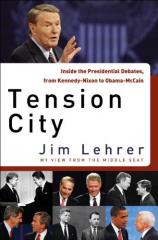Tension City: Inside the Presidential Debates, from Kennedy-Nixon to McCain-Obama
Review
Tension City: Inside the Presidential Debates, from Kennedy-Nixon to McCain-Obama
TENSION CITY is an entertaining and interesting view of the 50-year-old institution that has become the American presidential debates. While informative and enjoyable to read, Lehrer’s account of his years as debate moderator is also a disquieting book. He goes behind the camera lens to offer political junkies as well as casual readers great insight into the presidential and vice-presidential debates. From that perspective, TENSION CITY is a wonderful political memoir.
"While informative and enjoyable to read, Lehrer’s account of his years as debate moderator is also a disquieting book. He goes behind the camera lens to offer political junkies as well as casual readers great insight into the presidential and vice-presidential debates. From that perspective, TENSION CITY is a wonderful political memoir."
The disquieting aspect of Lehrer’s chronicle comes from an anecdote offered very early in the book. He recounts how, in 1988, ABC newsman Peter Jennings urged the four journalists chosen to question Michael Dukakis and George Bush to abandon the format chosen by the Commission on Presidential Debates and to instead demand that the candidates participate in an actual face-to-face debate. Lehrer and the other three participants declined Jennings’s invitation. For his part, Jennings recognized that the presidential debates have become more show than substance, but his desire to challenge the format was unsuccessful. One need only look back to the first debate between John F. Kennedy and Richard Nixon on September 26, 1960, to recognize that 50 years have not improved the informative value of the debates. Journalists share the blame for this decline. But there is no simple solution.
Setting aside the fact that the debates are not truly debates, Lehrer has done a wonderful job in recounting his participation in moderating 11 of the presidential and vice-presidential debates. One does not get chosen for such a role unless all participants are satisfied in the moderator’s objectivity and impartiality. Lehrer has earned a front-row seat to history by instilling confidence in all political camps that he will be a neutral and detached participant in the debates.
TENSION CITY is remarkable because almost all of the participants in these debates granted interviews to the author. They acknowledged faults and flaws, and candidly recognized that the debates had some influence on the voters’ decision on Election Day. The first presidential debate in 1960 increased Kennedy’s stature in the eyes of voters, while Nixon’s appearance on television hurt his campaign. Their answers did not separate them, but their appearance did. Kennedy looked younger and more vigorous. Most voters who watched the debate on television thought Kennedy won; those who listened on the radio picked Nixon.
After 1960, voters waited until 1976 for the return of debates. At that time, Gerald Ford was closing the large gap he faced with Jimmy Carter. Then Ford made his famous comment in the debate that Poland was not under Soviet domination. His momentum was stopped and Carter was elected. Four years later, Ronald Reagan, a master of the television medium, performed in a manner that made Americans feel comfortable with his candidacy, and he cruised to victory. In 1984, after a poor performance in his first debate with Walter Mondale, Reagan returned to form in the second debate and was reelected in a landslide.
Lehrer’s interviews and observations regarding critical events in the debate are instructive to those who believe in the importance of robust political debate. One common thread from the candidates is to downplay the significance of gaffes, whether beneficial or harmful. Each candidate seems to recognize that a multitude of factors go into the electoral decision of voters. Perhaps the candidates are correct, but if they are, one wonders why they seek to structure the debates to actually limit a free-wheeling and robust discussion.
TENSION CITY acquires its title from an observation by the first George Bush describing the pressure of the debates. It's an apt comment on their importance. But there is another tension, the tension among the politicians, journalists and voters, each with different needs and goals in the debate process. Reading Lehrer’s enthralling account of the presidential debates does not diminish the fact that they would be far more meaningful if they were viewed less as entertainment and more as substantive decision-making elements of the electoral process. Were that the case, Jim Lehrer would really have a story to tell America.
Reviewed by Stuart Shiffman on September 15, 2011
Tension City: Inside the Presidential Debates, from Kennedy-Nixon to McCain-Obama
- Publication Date: September 13, 2011
- Genres: History, Nonfiction, Politics
- Hardcover: 224 pages
- Publisher: Random House
- ISBN-10: 1400069173
- ISBN-13: 9781400069170




